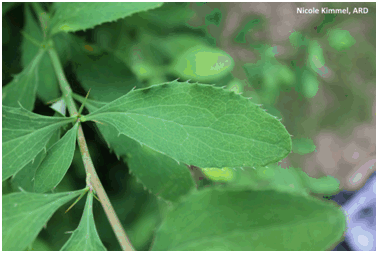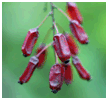
| |
Common Barberry (Berberis vulgaris) | |
| |
|
|
| |
|
|
| | Return to the Weed Information Home Page
.
Description
A deciduous shrub that can grow to 4 m high. The leaves are small oval, 2–5 cm long and 1–2 cm broad, with a serrated margin; they are borne in clusters of 2-5, subtended by a three-branched spine 3–8 mm long. The flowers are yellow, 4–6 mm across, produced on 3–6 cm long panicles in late spring. The fruit is an oblong red berry 7–10 mm long and 3–5 mm broad, ripening in late summer or autumn. This plant is a very important pest because its leaves become infested with the fungus which causes stem rust on oats, barley, rye and wheat; the fungus overwinters in these leaves and spreads from them to cause early-season infections of stem rust on nearby grain crops. Eradication of this shrub is essential to help protect grain crops from the stem rust fungus. |  |
 |
Key Identifiers
- 2nd year bark is gray, not brown, purple or reddish
- Stems have 3 branched spine
- Leaf margins have 16-30 teeth
- 10-20 flowered racemes
Location in Canada
Introduced as an ornamental to B.C., A.B., Man., N.B., N.S., Ont., P.E.I., Que. Isolated populations are known to be present in Edmonton. Importation and sale now prohibited by Canadian Food Inspection Agency (CFIA).
Resources
Similar species
It is distinguished from other shrubs by its clusters of bristly toothed leaves, its 3-branched spines, its small yellow flowers in long drooping racemes, and its red berries.
Other (Berberis sp.) – many species are grown as ornamental shrubs. Berberis thunbergii (Rose Glow) is probably the most popular species and is distinct by its lack of teeth on leaf margins and attractive pink-variegated burgundy foliage. Mill Creek Nursery - Rose Glow Barberry |
|
| |
|
|
| |
For more information about the content of this document, contact Chris Neeser.
This document is maintained by Shelley Barkley.
This information published to the web on April 2, 2012.
Last Reviewed/Revised on August 21, 2018.
|
|